#Ancient Artifacts Rediscovered
Explore tagged Tumblr posts
Photo










(via ""Bananas for Artifacts: Primate Excavators Unearth Human History" number 4" Essential T-Shirt for Sale by MarandSviet)
#findyourthing#redbubble#primate archaeology#Banana Republic Finds#Unearthing Human Legacy#Simian Scavengers#Primates Unleash the Secrets#Ancient Artifacts Rediscovered#Curating the Human Archive#Evolved Archaeologists#Humanity Reclaimed by Primates#Primate Perspectives#Chasing Human History#piecing together the past#Primate Preservationists#Ancient Civilization Revival#Exploring the Human Past#Primates Probe the Ruins#Secrets of the Banana Republic#Primates Excavate the Clues#Decoding the Human Remnants#Primates Unravel the Mystery
2 notes
·
View notes
Text

Bronze Bust of Roman Emperor Caligula Rediscovered After 200 Years
The small bronze statue, which was unearthed at Herculaneum, had been missing for two centuries
A curator in England has rediscovered a tiny Roman-era bronze bust of the emperor Caligula, which had been missing for some 200 years.
The artifact was unearthed in the mid-18th century at Herculaneum, the ancient town preserved under volcanic ash since Mount Vesuvius’ eruption in 79 C.E. Then, Horace Mann, the British ambassador to Italy, acquired the five-inch-tall statue and gave it to his friend, Horace Walpole, the British writer and politician.
The two friends even exchanged letters about the 2,000-year-old bronze, according to a statement from Strawberry Hill House, Walpole’s Gothic home in London.
“I gaze on it from morning to night. It is more a portrait than any picture I ever saw,” Walpole wrote in 1767. “The hair and ears seem neglected, to heighten the expression of the eyes, which are absolutely divine, and have a wild melancholy in them, that one forebodes might ripen to madness.”


Caligula is infamous for his eccentric and cruel behavior. Legend has it that the emperor was so obsessed with his horse, Incitatus, that he tried to make the animal a consul, though this rumor is likely untrue. His reign, which began in 37 C.E., was erratic. He was assassinated after only four years in power.
Today, only seven other small-scale bronze busts of the emperor are known to exist. When Walpole died in 1797, his Roman bust changed hands several times, with some owners mistaking the visage for Alexander the Great.
Silvia Davoli, a curator at Strawberry Hill, found the lost bust in the family collection of Sir John Henry Schroder, who had purchased it in the 1890s, per the statement.
As a curator of Walpole’s former estate, Davoli was familiar with the politician’s correspondence with Mann and knew of the statue’s existence. She had also seen a drawing of it, which Walpole had commissioned from the artist John Carter. When she came across the bronze in Schroder’s collection, she was able to match it to Carter’s drawing.
Schroder doesn’t appear to have known what the statue was or where it came from. According to Strawberry Hill, the family’s collection catalogs refer to the piece as a “possible Renaissance bronze of a youth.”
“They had no idea it was Caligula,” Davoli tells the Guardian’s Richard Brooks. “I was so happy when I finally saw the bronze and made the link.”


Because the statue hadn’t become discolored over time, experts had previously assumed it dated to the 16th century. However, a recent analysis of the metal confirmed that the bronze is, in fact, ancient.
Dietrich Boschung, an expert on imperial Roman iconography at the University of Cologne in Germany, has since examined photos of the statue.
“I’m convinced it is Caligula,” Boschung tells the Guardian. For him, the statue’s piercing silver eyes are a dead giveaway—a common feature of Roman-era bronzes depicting emperors. He also finds it feasible that the piece was once at Herculaneum. “Around that time, many Roman bronzes were found there,” he adds.
To celebrate the discovery, Strawberry Hill will include the ancient bust in its upcoming exhibition, “The Art of Treasure Hunting.” Visitors can check out the tiny Caligula statue for themselves when the show opens on June 28.
By Julia Binswanger.

#Bronze Bust of Roman Emperor Caligula Rediscovered After 200 Years#Roman Emperor Caligula#Herculaneum#bronze#bronze statue#bronze sculpture#bronze bust#ancient artifacts#archeology#archeolgst#history#history news#ancient history#ancient culture#ancient civilizations#roman history#roman empire#roman emperor#roman art#ancient art
100 notes
·
View notes
Text
actually fuck the louvre for having the code of hammurabi all my homies hate the louvre
#booooo stolen artifacts boooooooooooooooooo#it was rediscovered in ancient iran in 1906...... guy s ☹️#shamsisms
15 notes
·
View notes
Text
Murder Mystery, Occult, Paranormal & Fantasy Prompt Ideas for Writers
1. The Cursed Amulet - A wealthy collector is found dead after acquiring a cursed amulet. The protagonist must uncover the artifact’s dark history to solve the murder.
2. Blood Moon Ritual - During a blood moon, a prominent figure is sacrificed in a forbidden ritual. The investigator discovers a cult trying to summon an ancient deity.
3. Witch’s Grimoire - A renowned witch is murdered, and her grimoire is stolen. The book contains spells powerful enough to alter reality.
4. Haunted Manor - Guests at a secluded manor start dying mysteriously. It’s said the house is haunted by vengeful spirits from a tragic past.
5. Necromancer’s Revenge - A necromancer brings people back from the dead to seek revenge on those who wronged him, resulting in a string of murders.
6. Sorcerer’s Apprentice - An apprentice sorcerer is killed during a magical experiment gone wrong. The protagonist must navigate a web of magical deceit to find the killer.
7. Alchemical Poison - A series of deaths caused by an untraceable poison leads to an alchemist who’s using forbidden knowledge.
8. The Phantom Assassin - A shadowy figure with supernatural abilities is killing off members of a secret society.
9. Demon Pact - A series of murders mimic those described in an ancient text about summoning a demon. The protagonist suspects a pact with dark forces.
10. Arcane Library - A librarian is found dead in a magical library where books can come to life. The books themselves hold clues to the murder.
11. Midnight Masquerade - At a masquerade ball, a guest is killed, and the murder is linked to an ancient ritual involving the masks.
12. Sacred Relic - A sacred relic is stolen, and those connected to its theft are being murdered by a guardian spirit.
13. Time-Worn Curse - An old curse reawakens, killing the descendants of the original cursed family. The investigator must break the curse to stop the murders.
14. Vampire’s Thrall - Murders in a town coincide with the arrival of a charismatic stranger who may be a vampire seeking revenge.
15. Elemental Fury - A mage controlling elemental forces is killing people who wronged him in the past. Each murder is committed using a different element.
16. Runic Inscription - Victims are found with runic inscriptions burned into their skin, leading the protagonist to an ancient prophecy.
17. Ghost Ship - A ship thought lost at sea reappears, its crew murdered. The investigator discovers the ship’s cursed history.
18. Puppet Master - An enchanted puppet is killing those who mistreated its creator, a deceased toymaker.
19. Celestial Alignment - Murders align with celestial events, suggesting a ritualistic pattern. The protagonist races against time to prevent the next murder.
20. Shadow Realm - Victims are being dragged into a parallel shadow realm, their bodies found drained of life.
21. Enchanted Forest - People who enter a forbidden forest are found dead, their bodies entwined with enchanted vines.
22. Murderous Djinn - A djinn, bound to an artifact, is killing people who come into possession of it.
23. Spellbound Love - A love potion gone wrong leads to obsessive love and murder.
24. Seer’s Vision - A seer predicts their own murder and enlists the protagonist to prevent it, but the future seems immutable.
25. Ritual Dagger - A dagger used in ancient sacrifices is rediscovered, and each person who touches it is killed.
26. Charmed Life - A person with a charm for eternal life starts aging rapidly and dies under mysterious circumstances.
27. Mystic Tattoo - A tattoo artist’s clients are being murdered, their tattoos turning into deadly curses.
28. Dragon’s Curse - A dragon’s curse starts killing those who stole from its hoard.
29. Mirror of Truth - An enchanted mirror reveals the darkest secrets of those who look into it, leading to a series of murders.
30. Ghostly Whisperer - A medium is killed by a spirit they summoned, who continues to haunt and kill.
31. Warding Sigil - A town’s protective sigil is broken, unleashing vengeful spirits on the townspeople.
32. Sorcerer’s Duel - A duel between powerful sorcerers results in one’s death, but the victor’s life is now in danger.
33. Forbidden Love - Star-crossed lovers from rival magical factions lead to a series of revenge killings.
34. Haunted Heirloom - An heirloom brings death to the family that inherits it, linked to an ancestor’s dark pact.
35. Shapeshifter’s Hunt - A shapeshifter is targeting a specific group, blending in seamlessly until the protagonist uncovers their true nature.
36. Arcane Academy - A student at a magical academy is killed during a spell-casting exam, and the murder is linked to a dark secret of the school.
37. Spectral Assassin - An assassin’s ghost seeks revenge on those who betrayed him in life.
38. Illusionist’s Game - An illusionist’s final trick results in real deaths, with magic and deception intertwining.
39. Golem Rampage - A golem goes on a killing spree, and the investigator must find its creator to stop it.
40. Philosopher’s Stone - A hunt for the philosopher’s stone leads to deadly competition and betrayal.
41. Mystic Caravan - A traveling caravan brings death wherever it goes, linked to an ancient curse.
42. Sealed Tomb - An ancient tomb is opened, releasing a vengeful spirit that begins killing those responsible.
43. Moonlit Beast - A werewolf’s attacks coincide with the full moon, but this werewolf is being controlled by someone with dark intentions.
44. Soul Harvest - Victims are found with their souls extracted, leading to a dark sorcerer seeking immortality.
45. Witch Hunt - A series of witch trials results in the wrongful deaths of innocents, whose spirits now seek vengeance.
46. Crystal Prophecy - A prophecy within a crystal ball foretells murders, but the seer is manipulating events to fulfill it.
47. Enchanted Theater - Actors in a theater troupe start dying in ways that mimic their cursed roles.
48. Dark Covenant - A secret society’s members are being killed off one by one, linked to a broken blood pact.
49. Doppelganger’s Curse - Victims are replaced by malevolent doppelgangers who are committing murders in their place.
50. Forgotten Sanctuary - An ancient sanctuary is disturbed, releasing an entity that begins killing those who desecrated it.
#writer#writerscorner#writing#writing inspiration#writer things#writerblr#writing tips#author#writers and poets#ao3 writer#paranormal fantasy#paranormal#occult#murder mystery#mystery thriller#mystery writer#fantasy writer#writing inspo#writing resources#writing community#writer stuff#writers on tumblr#writing prompt#writer prompts
207 notes
·
View notes
Text
I wanna go a bit full-circle with a post I did right after the first two episodes of ‘Fionna and Cake’ dropped - about the nature of Simon Petrikov’s sense of identity. And more specifically, with how his titular episode centered around the ways his deteriorating mental state and the new context of his life has really torn away at everything Simon used to define himself as.

Because Simon Petrikov used to be a lot of things. He was an antiquarian and an archaeologist, a man deeply fascinated by the concept of Magic and the supernatural in a mundane world that ridiculed him for it at every turn, an adventurous outdoorsman, and a deeply caring and fatherly man.
But when we meet him at the start of “Simon Petrikov”, he has lost all the passion for his job - especially as he now has to perform it basically as a living museum exhibit. He is now stuck in a word filled with Magic and feels like the only mundane thing in it. He is unable to handle the sort of dangers you would find in an Oooian camping trip. And he made a little girl cry.
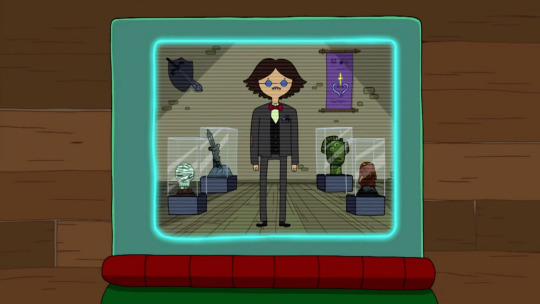



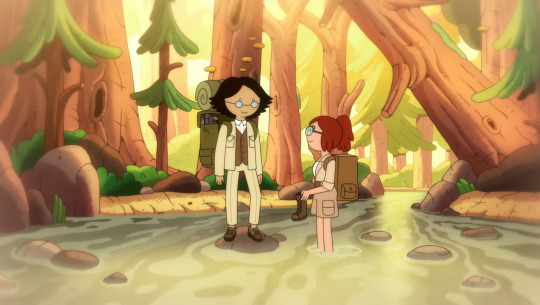
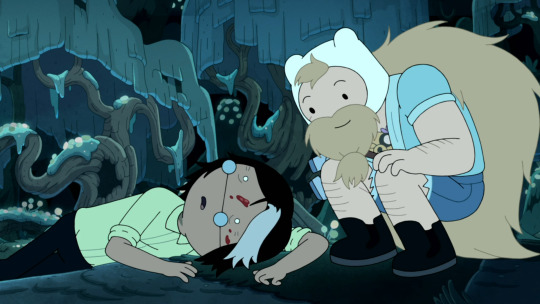


And there’s one more thing Simon used to define his identity as, and that is the one he ended up clinging to more than anything in that one episode, even though it was just as decimated as every other facet of his old identity, and the one that ends up jump-starting the plot. And that is being Betty Grof’s other half.
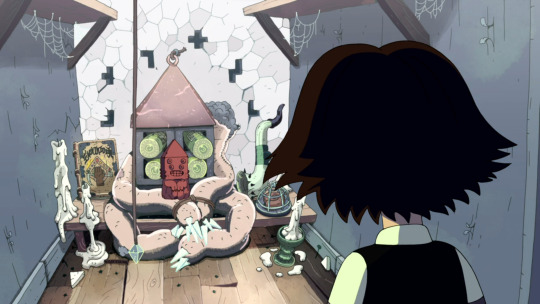
So now, looking back at this second episode at the end of the series, it really feels appropriate that throughout his adventures Simon managed to rediscover these old elements of his personality, that all these aspects of his identity managed to get reinforced and validated…
For most of the series he was basically doing his old job again - travelling around, trying to discover and uncover an ancient artifact.

And you can really see how he regains his excitement for research.
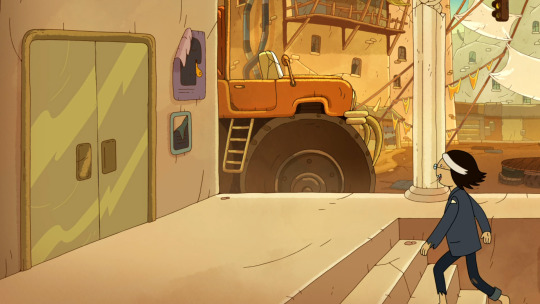
And by the end of the show, he ends up really rediscovering a passion for his work (and also realized that this Living Museum Exhibit set-up is not conducive for his mental health, which is also a step in the right direction).
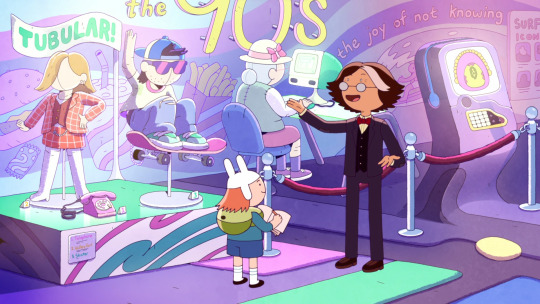
And he gets to show-off his understanding of Magic
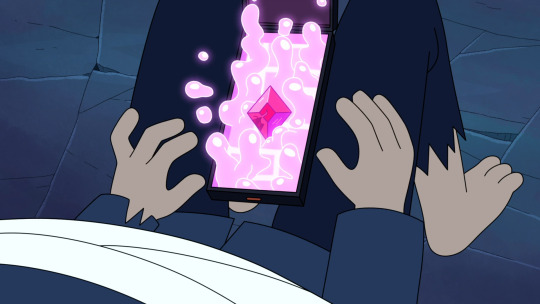
And by the end of the show, Simon doesn’t feel like such an outsider in Ooo anymore. Probably helped by the fact his cellphone connection with Fionna gives him that little connection to 'normalcy' he was missing.
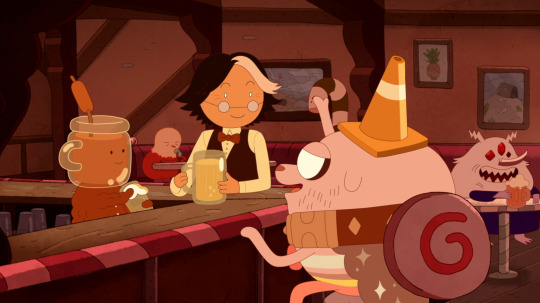
And he got to go on an adventure again, and handle it better than his Camping Trip Funtimes with Finn. Probably because he was around Adventure Novices Fionna and Cake, who were a bit closer to his ‘level’ than a crazy-seasoned adventurer like Finn

And by the end of the show, you can see him seeking thrills on his own terms.
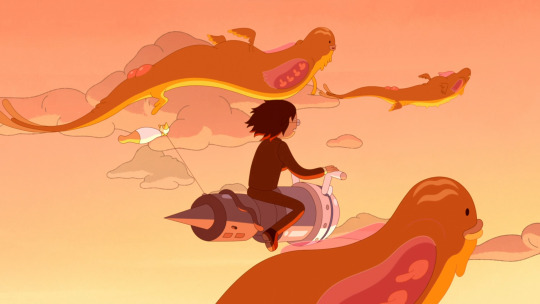
And his ability be kind and fatherly and comforting was validated both by his constant interactions with Fionna - who isn’t a child, but is still a younger person who often needed his emotional support

And also by a very grim reminder of how truly important he was for Marcy.

And by the end of the show, he has managed to make a connection with Astrid, despite them starting out on such a sour note.

But 'Simon Petrikov, Betty Grof's beloved'? That aspect of himself did get some validation, via him getting to share their love story with Fionna
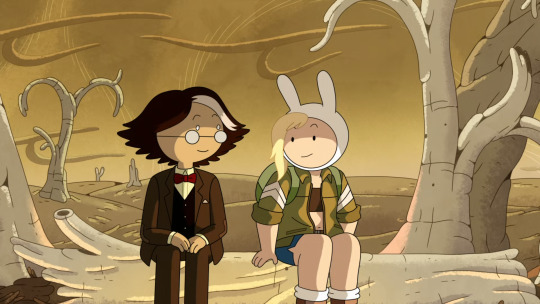
But it was not entirely validated, was it? That was the one aspect of himself that was actually challenged - the one part of himself was clinging to like a lifeline when he felt like he was falling apart, that was the one part of himself that he had to both recontextualize in his head and eventually realized he had to finally let go off…

#adventure time#atimers#fionna and cake#fionna & cake#at#at spoilers#fac#fac spoilers#f&c#f&c spoilers#cheers#casper and nova#adventure time fionna and cake#at fionna and cake#adventure time spoilers#adventure time simon#fionna and cake spoilers#fionna and cake simon#fionna and cake series#fionna and cake show#simon petrikov#simon adventure time#simon and betty#petrigrof
580 notes
·
View notes
Photo
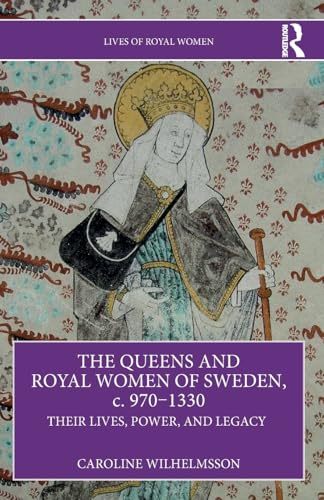
The Queens and Royal Women of Sweden, c. 970–1330
As a new and unique study of Swedish royal women and queens from the Middle Ages, this book deserves recognition. Biographies of both well-known and lesser-known queens make it a valuable resource for students at colleges and universities as well as a new tool for professors and researchers. Students of history, women's studies, the Middle Ages, and social and cultural history will rediscover the true importance of Sweden's queens from an original perspective.
The Queens and Royal Women of Sweden, c. 970–1330: Their Lives, Power, and Legacy by Caroline Wilhelmsson is a compelling examination of the significant royal women in Sweden during the late Viking Age and early medieval period. This textbook uncovers the political power, stories, and struggles of queens in Scandinavian history. Queens of medieval Europe have long been a fascination. This book goes beyond the traditionally mentioned royal women of Europe and provides a new understanding of cultural contributions, painting a vivid portrait of the impact of Swedish queens throughout history.
As a groundbreaking first edition, this is a must-read for enthusiasts of medieval history and women's studies. The Queens and Royal Women of Sweden is tailored specifically for college and university students, instructors, and lifelong learners who are passionate about studies of the Middle Ages, European history, and women’s and gender studies.
Caroline Wilhelmsson is currently a postdoctoral researcher at University College Cork. With her book, she uncovers stories of women who have often been overlooked or misrepresented in traditional masculine historical narratives. In addition, while many works dedicated to medieval queenship concentrate on England or France, Wilhelmsson's focus on Sweden provides a refreshing and much-needed perspective, making this book a must-have for scholars in this area of interest. This book stands out also due to its various maps, family trees, and a comprehensive list of kings, their queens, and royal women. There are several images and artworks portraying some of Sweden's earliest queens as well.
This monograph is unique and is the first of its kind. It includes new perspectives on the historical context of royal women in European history. As part of the Lives of Royal Women academic series by Routledge, this detailed compilation of biographies of Sweden's early royal ladies allows readers to explore their positions, power, influence, and contributions to diplomacy, governance, and cultural advancement in medieval Scandinavia.
The book follows a thematic structure and chapters that explore key aspects of queenship, including the politics and dynamics of ruling, the roles of women in royal courts, and the influence of religion and culture. Wilhelmsson examines artifacts, written records, and architectural evidence to build a vivid picture of medieval queenship. Her focus on these women's lives and historical relevance, as well as including both famous and lesser-known queens, makes the book insightful and moving. The text also delves into ancient royal dynasties and the complex interplay between Christianity and paganism, offering a rich analysis of how these belief systems shaped queenship and royal authority.
The primary focus is on the varied and multifaceted roles of royal women. Wilhelmsson highlights how some women, such as Gunnhild of Sweden, Rikissa (Richeza) of Poland, Gunnhild of Denmark, Margareta Fredkulla, and Ragnhild of Talje, navigated the balance between pagan traditions and the growing influence of Christianity. These queens frequently functioned as political leaders and influencers in their own right, serving as bridges between the cultural and religious worlds. The book also delves into the intriguing concept of women being referred to as monarchs rather than queens, underscoring their ability to wield independent political power within a patriarchal framework.
Wilhelmsson maps the intricate web of relationships between Sweden and other European countries, shedding light on marital alliances and trade in particular. Sigrid Storrada, a queen of Slavic descent whose story illustrates how cross-cultural contacts shaped the royal courts of Sweden and beyond, is a prime example of this. The biographies of these powerful women, who often crossed borders and countries, provide an in-depth look at how trade routes and political marriages fostered exchanges that enriched royal courts and governance, leaving lasting legacies on both sides of Europe.
In conclusion, this groundbreaking book brings to life the stories of medieval royal women who ruled Swedish lands and their enduring impact on history. Wilhelmsson’s dedication to uncovering these narratives is a service to scholarship and society, providing an essential resource for anyone interested in European history, gender roles, and the medieval world. This book educates and inspires, underscoring the importance of preserving and studying the legacies of women whose contributions have too often been overlooked. Anyone seeking a deeper understanding of medieval queenship and the intricate tapestry of European history should delight in this recommended textbook.
Continue reading...
31 notes
·
View notes
Text
Transformers Priest au
In an alternate universe of "Transformers Priest," Cybertron is on the brink of destruction, caught in an endless war between Autobots and Decepticons. To prevent their sacred relics from falling into the wrong hands, the Priests of Primus, an order of devout guardians, decide to disperse these powerful artifacts across the universe. Among these relics, the most precious is the Chalice of Primus, a blood-red crystal with golden veins, capable of strengthening armor and granting near-miraculous regeneration to wounded Cybertronians.
This Chalice ends up on Earth in the midst of the Inquisition. Humans, upon finding this artifact and seeing the arrival of the Priests, interpret these visitors as angels sent by heaven. Convinced that their mission is divine, the humans take it upon themselves to protect the Chalice in secret, hiding it in an abbey and passing their mission down through the generations, as the Chalice gains the reputation of being a “Holy Grail.”
In modern times, the Chalice of Primus is rediscovered during an archaeological dig. When activated, its energy is detected in the cosmos, drawing the attention of the Autobots and Decepticons, who see in it a tool capable of tipping the balance of the war in their favor. Both sides head to Earth, where they find a humanity that still perceives the Autobots as angels and the Decepticons as fallen angels, corrupted by darkness.
Optimus Prime and the Autobots try to explain to the humans that they are not divine, but alien beings in a war to protect the universe. However, humanity's faith is unwavering: they see the Autobots as the embodiment of goodness and the Decepticons as absolute evil, demonic entities that seek to destroy everything they touch. Taking advantage of this perception, Megatron and the Decepticons sow fear among humans, forcing them to surrender the Chalice to their control.
Finally, the decisive battle takes place in the ancient abbey where the Chalice is located. In their confrontation, the artifact is destroyed, splitting into two halves: one falls into the hands of Optimus Prime and the other into those of Megatron. As each takes a part, both leaders are drastically transformed, with the power of the Chalice reflected in them.
Optimus Prime acquires imposing armor with golden details that shine, and on his back emerges a metallic cape that can unfold like wings, giving him an angelic and majestic air. The Chalice fragment he holds becomes a magnificent scepter, capable of healing and restoring his allies, renewing their strength in battle. Humanity now sees him as a true war angel, the god-like figure they had always imagined.
Megatron, on the other hand, upon absorbing his half of the Chalice, transforms into a shadowy figure. His armor darkens and takes on a dull golden glow, while the Chalice fragment in his hands becomes a sharp, dark scepter, radiating crimson energy. Megatron becomes a figure of destruction and chaos, fueling human beliefs that he is a demonic being, a corrupted, fallen angel, bringer of death.
The Chalice, divided, grants partial blessings to both sides. The armor of the Autobots and Decepticons is enhanced, with golden details reflecting the holy powers they now possess. Humanity is caught between these two colossi: the Autobots, whom they regard as sacred protectors, and the Decepticons, whom they view as harbingers of doom. The conflict over the Chalice of Primus becomes an epic battle between the sacred and the profane, a symbolic struggle whose outcome could decide the fate of both Earth and Cybertron.
#transformers#optimus prime#megatron#autobots#decepticons#alternate universe#transformers optimus#transformers bumblebee#bumblebee#elita one#starcream#soundwave#transformers au#religious imagery
27 notes
·
View notes
Text
Heritage News of the Week
Discoveries!
Archaeologists in London have found the remains of the city’s first basilica underneath the basement of an office building set to be demolished. Dubbed “the beating heart of Roman London,” it has been deemed one of the most important finds from the city’s Roman history.
Major discovery of a pre-Roman necropolis in Trento
More than 200 tombs have been discovered beneath layers of Roman and medieval material, at a depth of eight metres below the current street level.
Gold jewelry with leopard and tiger designs unearthed in 2,400-year-old burial in Kazakhstan
Striking gold jewelry and weapons made by Sarmatian nomads have been unearthed from three burial mounds in Kazakhstan that date to about the fifth century B.C.

Britain’s largest Viking Age building found near Holme St Cuthbert
Archaeologists from Grampus Heritage & Training Limited have uncovered a Viking Age timber building near the village of Holme St Cuthbert, located in the county of Cumbria, England.
People have been dumping corpses into the Thames since at least the Bronze Age, study finds
A new study of human remains dredged from the Thames River reveals that people frequently deposited corpses there in the Bronze and Iron ages.
Recent excavations unveil five remarkable statues, shedding light on Perge’s Roman heritage
During the excavations in the ancient city of Perge in Antalya, one of the most organized Roman cities of Anatolia, five different statues were unearthed.
Man buried with Roman pugio found at ancient fortress
Excavations at Cortijo Lobato, conducted during the construction of a new photovoltaic park, have revealed the skeletal remains of a man buried with a pugio (a Roman dagger) placed on his back.
Burial of ascetic monk in chains reveals surprising identity: A woman in Byzantine Jerusalem
A recent archaeological discovery near Jerusalem has challenged long-held beliefs about ascetic practices in the Byzantine era, revealing the remains of a woman in a burial typically associated with male ascetics, thus prompting a reevaluation of women’s roles in extreme religious traditions of the 5th-century AD.
Rare bronze beverage filter discovered in Hadrianopolis
Archaeologists excavating in Hadrianopolis, located in Turkey’s Karabük province, have discovered a 5th century AD bronze object believed to have been used as a beverage filter.
2,000-year-old artifacts found at Swat’s Butkara site in Pakistan, including coins and Kharosthi inscriptions
Excavations at the Butkara Stupa, located near Mingora in Swat, Pakistan, have uncovered significant findings, including two-thousand-year-old coins, pottery, and inscriptions in the Kharosthi script, all of which provide valuable insights into the Saka-Parthian period and the rich Buddhist heritage of the region.
Key Silla Kingdom palace site found in South Korea after decade-long probe
A decade-long investigation conducted by the Korea Heritage Service has uncovered a crucial palace site of the Silla Kingdom (57 BC-935 AD), revealing findings that could potentially reshape the historical narrative of this ancient kingdom.
Cemetery for enslaved people rediscovered at Andrew Jackson’s Tennessee plantation
Long-obscured and forgotten, the burial plots of more than two dozen people enslaved by the seventh president of the US are located and honoured
Museums
The Textile Museum of Canada will close its doors on 16 February, with a re-opening date still to be determined but tentatively expected in September. Funding is a major concern, along with accessibility—the building’s elevator is in need of serious repair.
The Alabama museum grappling with the 'Gulf of America'
The world's only museum dedicated to the history and culture of the Gulf of Mexico may be in hot water following Trump's decision to change the name of the planet's largest gulf.
I feel for this museum. They spent $100,00 to rebrand and less than a year later the orange one blows things to pieces.
Also, @greenekatgrey, fyi, this museum is planning an exhibit about your favourite, Jimmy Buffett.
The Bunny Museum in LA looks to rebuild after fires
The co-founders of the world’s largest collection of rabbit-themed items want to recreate “the hoppiest place in the world.”
History lovers invited to sketch museum artefacts
A Devon museum is encouraging people to get closer to their local history - by drawing it.
Repatriation
National Museums Northern Ireland (NMNI) is to return further human remains to Hawaii.
Have you seen this book?
The initiative ‘Have you seen this book?’ also known as the Library of Lost Books, is run by the Leo Baeck Institute and intends to both publicise the history of these books in a beautifully created interactive exhibition and to appeal to the general public for their support in locating them.
Heritage at risk
The Uzbekistan government is on an ambitious tourism drive – but is sparring with heritage experts over how to protect its historical sites.
AI-powered initiative HeritageWatch.AI to safeguard cultural heritage from crises
HeritageWatch.AI, a new collaboration launched in Paris, combines satellite imagery, 3D modelling, and AI to provide real-time data that will help protect cultural heritage sites from disasters and conflict.
Organised crime threatening cultural heritage by trafficking irreplaceable artefacts
Cultural artefacts and historic sites around the world are being threatened by organised crime groups who traffic the items for lucrative profits, a team of researchers from The University of Queensland found.
Israeli bill on West Bank antiquities oversight faces opposition from government body
The Israel Antiquities Authority (IAA), a body of the Israeli government that oversees national artifacts and sites, rejected a proposal to take on an official role overseeing West Bank antiquities under a bill presented by Likud party member Amit Halevi on Tuesday.
As Sudan’s civil war rages on, its heritage is under siege
At least six museums and multiple historic sites have suffered looting or damage as a result of the conflict
Odds and ends
Almost eight centuries after it was crafted in a workshop in Salisbury, the Sarum Master Bible, a vividly illustrated medieval manuscript, has returned home and will go on display at the city’s cathedral this month.
Iraq’s ancient marshes are running out of time
Iraq’s southern marshes, the birthplace of early civilization, face ruin from environmental and political mismanagement. As the water disappears, so too does a 5,000-year-old culture.
Smell like an Egyptian: researchers sniff ancient mummies to study preservation
Scientists hope that smell could be a non-invasive way to judge how well-preserved a mummy is
The landmark home of a California family was destroyed by fire. Now a city reckons with its painful history
The Bidwell mansion was a symbol for the city of Chico, but for some it was a reminder of colonization and genocide
Library Crunchie muncher sought for 'relic' wrapper
Workmen dismantling shelves at Cambridge University Library got a sweet surprise when out fluttered an old chocolate bar wrapper from at least 50 years ago.

Blue plaque unveiled to honour boy chimney sweep
A blue plaque to commemorate a Victorian child chimney sweep has been unveiled at the place of his death. George Brewster, 11, became trapped in the chimney in 1875, and could not be saved. He is thought to be the last of what were known as "climbing boys" to have died in England.
Groundbreaking botanical discoveries on Captain Cook voyage were thanks to Indigenous people
New book reveals that Pacific islands inhabitants helped European scientists identify hundreds of plant species
Date set for Sycamore Gap tree felling trial
Daniel Graham, 39, and Adam Carruthers, 32, both from Cumbria, are charged with causing £622,191 worth of criminal damage to the famous Northumberland tree.
16 notes
·
View notes
Text

On a tragic day in 79 AD, Mount Vesuvius erupted with cataclysmic force, forever altering the landscape of the Roman Empire. While the nearby city of Pompeii often takes center stage in discussions of this disaster, the neighboring city of Herculaneum holds an equally haunting and compelling story. Unlike Pompeii, which was buried under a layer of ash, Herculaneum was engulfed by a river of superheated volcanic mud and pyroclastic surges. This thick covering preserved the city in remarkable detail, offering us a rare and intimate glimpse into the lives of the ancient Romans.
A Glimpse Into Roman Life
One of the most fascinating aspects of Herculaneum is how its preservation allows us to see the structure of Roman society. Wealthy Romans lived in grand villas adorned with intricate mosaics and frescos, complete with private baths and gardens. These homes would have overlooked the sparkling Mediterranean, offering a serene view of the sea. Today, the preserved remains of these villas provide a rare glimpse into the luxury and sophistication that characterized the lives of the upper class in Roman society.
But Herculaneum was not just a city for the wealthy. Archaeologists have also uncovered modest homes and public buildings, such as baths, bakeries, and taverns, that catered to everyday citizens. These findings have allowed historians to reconstruct not only the architecture but also the social dynamics of the time, from the bustling marketplace to the intimate gatherings in private homes.
Lessons From the Past
The tragic fate of Herculaneum’s inhabitants serves as a stark reminder of the power of nature and the fragility of human life. The rediscovered beachfront area, with its skeletal remains and tragic stories, brings home the immediacy of the disaster in a way that mere words or artifacts cannot. As you stand on the site where these ancient people perished, it is impossible not to reflect on the suddenness with which life can change.
Yet, out of this tragedy has come one of the most extraordinary archaeological discoveries of all time. Herculaneum offers us a unique opportunity to understand the world of ancient Rome in intimate detail, from the artistry of its frescoes to the everyday objects that tell stories of ordinary lives lived thousands of years ago.
Conclusion
The beachfront of Herculaneum is not just a tragic site of loss; it is also a place of profound discovery. Through the preservation of the city and its inhabitants, we have gained invaluable insights into Roman society, art, and daily life. As visitors walk through the ancient streets of Herculaneum, they are transported back in time to a moment frozen by nature’s fury. In doing so, they are reminded of the resilience of human culture, even in the face of overwhelming disaster.
7 notes
·
View notes
Text
My problem with AIVAS is that it’s not NECESSARY
The pernese don’t need deus ex AI, they’ve spent the last decade plus rediscovering their ancient history all on their own. And yeah, it speeds things up a bit to have a machine that magically tells everyone exactly what they need to know and do, but tons of other things could serve that purpose.
Imagine how much more fun it would be if the history of the first crossing and Landing was discovered when someone saw the murals painted at Honshu, and microbiology info was hidden in Wind Blossom’s labs at Fort, and a normal old computer with some files detailing the plan to move the red star was uncovered, along with Emily Boll’s desktop photo of her family.
Imagine the awe and eeriness of the pernese learning exactly what they need to know while touching tbe artifacts of their ancestors! But instead we get AIVAS rolling out lists of bland facts and taking the fun out of everything
#all the weyrs reread#all the weyrs of pern#aivas#pern reread#pern#dragonriders of pern#anne mccaffery
38 notes
·
View notes
Text

Unknown ancient cultures are always fascinating. This one sounds nice to have lived in.
“Archaeologists recently rediscovered the long-hidden traces of an ancient Indigenous society in western Ecuador’s Upano Valley: more than 6,000 earthen platforms that once supported houses and communal buildings in 15 urban centers, set amid vast tracts of carefully drained farmland and linked by a network of roads. Stéphen Rostain of the French National Center for Scientific Research and his colleagues say they haven’t seen this unique brand of “garden urbanism” anywhere else in the ancient Americas. It is also the oldest such civilization uncovered in the area…
The artifacts that Rostain and his colleagues excavated from the house platforms suggest that people built this complex network of communities around 2,500 years ago and abandoned it sometime between C.E. 300 and 600. Rostain thinks “perhaps a series of eruptions could have made trouble for the people, because after [C.E.] 600, we don’t have any archaeological dates until [C.E.] 800.”…
Each settlement included several groups of platforms, with roads connecting them. Some settlements were small, with just a few house platforms per square kilometer, but others—such as Sangay, which overlooks most of the valley—packed more than 100 platforms into each square kilometer of a site the size of Central Park. And these larger, denser urban centers boasted taller, wider platforms that probably once held communal buildings where people might have gathered for rituals, shared work or social events, Rostain and his colleagues suggest…
Nearly all the open space between communities would have been covered with hundreds of hectares of fields, bordered by shallow drainage ditches that fed into deeper canals. That close link between the fields and the urban centers of the Upano Valley is a unique hallmark of the landscape and the people who built it. Rostain and his colleagues call it “garden urbanism.”




38 notes
·
View notes
Text
Halo Reloaded: Master Chief & more about Spartans
Born and raised on Eridanus-II, John Downes was the son of bioengineers and gardeners, who wanted to genetically modify Earth-plants to be sustainable on other planets (everyone, up until this point, had just been using the indigenous plants from the alien worlds they colonized); up until he was taken into the Spartan Program, John attended a school known as "The Reach For Life Foundation," a prestigious upper-class school (that was created on Reach before expanding out to the rest of the galaxy) designed to turn all of it's students into the next generation of pioneers, colonizers and explorers who will bring life into the uncharted reaches of space. Humanity came in contact with The Covenant in the year 2511. The Spartan Program saw production in 2517; most of the Spartans were born in the year 2528, while John Downes was born in the year 2530. That two year gap may as well have been a chasm between him and his brothers-&-sisters-in-arms. But, like in canon, the main reason why John was chosen despite being everyone's junior was because he still exhibited the exact same unique genetic-markers that all of the others do. With John being the youngest, he's needed to prove himself to the others by working and training thrice as hard as everyone else; his angst comes from the fact that, because he's the youngest, he's the most generic one of the group. He's not the fastest (that's Kelly), not the strongest (that's Samuel), not the biggest (that's Jorge), the best combatant (Fred), the best at weaponry (Vannak), the best at demolitions (James), the best shot (both Linda & Kai, who are rivals to each other, beat John out), the smartest (Riz), the best pilot (Daisy), the best at technology (Joshua), the one with the best intuition (Kurt), or the most charismatic leader (Jerome); he's only really impressive in comparison to the standard marine, this angst he faces is something he later comes to accept as he gets older. He eventually embraces his status as 'The Generic One' and becomes the Jack-of-all-trades, the one everyone can lean on for just about anything; the "Swiss-Army Spartan," if you will. They all got augmented, and the rest is history; but it wasn't until Operation SILENT STORM, the Spartans' FIRST mission as Spartans, where John was given the rank of "Master Chief Petty Officer," the highest rank a non-commissioned serviceman in the Navy can attain; he even got his first metal, "The Purple Heart," after he got shot on the line of duty (and survived, obviously). When he was a kid, before being inducted, John had discovered an ancient Forerunner rock (not that anyone knew what it was) that had almost possessed him; his obssession over it resulted in his father forcing John to bury the drawings he made of it in the backyard. The training and conditioning of the Spartan Progran, while not designed to brainwash anyone, did result in John repressing any memory of the rock. In the present (2552), John had discovered a similar rock during an extraction mission on Biko, which brought a terrifying wave of memories back to him; this drives him to rediscover the rock he found as a kid back on Eridanus-II, in cave beneath the abandoned ruins of his father's old Solar-Paneled Garden Field. After some back and forth battles between The UNSC and The Covenant, John is quick to deduce that the rock he found on Biko is a keystone to the artifact that he found as a kid; with two rocks joined together, they create a starmap that leads to the one thing The Covenant had been after this entire time: Halo.
Spartans are much younger here than in canon, being in their early 20s as opposed to being in their 50s like in the show and the games. Their youth, combined with their less traumatizing upbringing, makes them more colorful in their personalities (still professional and their canon personalities are about the same, but they're less sociopathically brusque and terse like in-canon). Super-Soldiers in media are usually portrayed with two major qualities: Extreme Aggression and Complete Obedience. They're designed to be ruthless killers, desensitized to violence, who are more aggressive than the average soldier, as they are more than willing to make the hard-choices and will not stop until their opponents are dead ("They [Spartans] just... keep killing. Until there's nothing. Left. To kill... You in or out?" - Angus; Halo, Season 1 - Episode 1) and the battle is won. As for complete obedience? Well, that's self-explanatory; they are happiest when given an order and only do what's asked of them ("Good soldiers follow orders." - Crosshairs; The Bad-Batch). The Spartans as seen in Halo Reloaded are the opposite. They're trained in: Lateral Thinking, Improvisation and Freestyling. They're very creative, on and off the field, people who are capable of salvaging a busted plan and thinking on their feet in the midst of high-stress situations; which is precisely why they're so good at their jobs, BECAUSE they're not dependant on the word of their superiors. They're less an army of Robocops and moreso an army of Captain Americas. John himself, particularly in his later years at 22, is a more "Commander Shepard' type of person: Swashbuckling, noble, still emotionally guarded but far less traumatized, charismatic (again not as much as Jerome) and often goes with the flow. He's still much more brusque and aggressive in comparison to the other more lively Spartans (the others often call him "the mean one"), but he's still as nice and compassionate as he's always been.
@ionlymadethissoicouldleaveanask
@mrtobenamedlater
@killer-orca-cosplay
@biomecharnotaurus
@authortobenamedlater
#john-117#master chief#halo fanfic#halo#halo fanfiction#Halo au#Halo headcanon#halo reloaded#ultimate universe
31 notes
·
View notes
Text

A Lost 4,400-Year-Old Tomb Found With Ancient Egyptian Mummy Inside
Archaeologists have rediscovered a lost tomb that contains the mummy of an ancient Egyptian official.
The tomb belonged to Ptahshepses, who lived around 4,400 years ago during the 25th and 24th centuries B.C. Archaeologists with the Czech Institute of Egyptology at Prague's Charles University said this week they located the tomb near the archaeological sites of Abusir and Saqqara in 2022 by using satellite imagery and studying old maps. Further excavations were conducted at the site this year.
The tomb was partially exposed almost 160 years ago by the French scholar Auguste Mariette, who uncovered an intricately decorated false door with a lintel, or a kind of supporting beam. But not long after the discovery, the tomb disappeared under the desert sand.
The false door and lintel contain information about Ptahshepses' official career, telling the story of his education at the court of Menkaure, an ancient pharaoh who was born in 2532 B.C. and died in 2504 B.C.
According to the information on the false door, Ptahshepses married the daughter of Userkaf, a pharaoh who reigned for a short period in the early 25th century B.C.
This reference itself indicates that Ptahshepses is the first known official of non-royal descent in Egyptian history who was given the privilege of marrying a royal daughter," the Czech Institute of Egyptology said in a Facebook post.
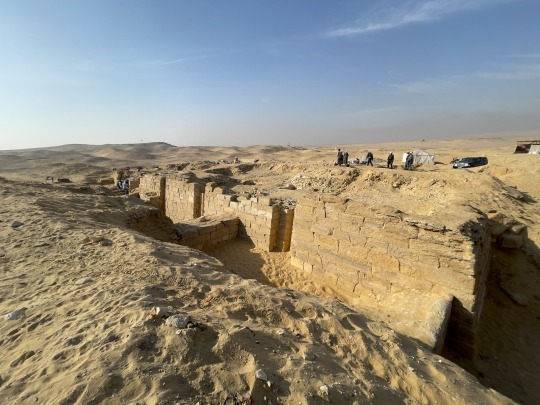

In addition, on the lintel there is a reference that is one of the earliest attestations of the deity Osiris, the god of fertility and the embodiment of the dead.
"This makes the official Ptahshepses even more unique because he can be credited with the idea of introducing the famous god of the Egyptian afterlife into the Egyptian pantheon," the Facebook post said. "Given Ptahshepses' political, historical and religious significance, the tomb is one of the most remarkable discoveries of the recent periods in Egyptian archaeology."
Excavations at the site uncovered an extensive, 137-foot-long and 72-foot-wide superstructure of the tomb. It includes a relatively well-preserved chapel with painted decoration in the entrance and a long access corridor.
This past spring, archaeologists examined the burial chamber, which appeared to have been robbed in antiquity. Nevertheless, it still featured some original funerary artifacts (including pottery), the remains of votive offerings, jars and a mummified fish.
In addition, researchers found a partially opened sarcophagus with the complete mummy of Ptahshepses inside.
Examination of the mummy by Egyptian anthropologists has provided important new data on the evolution of mummification during Egypt's Old Kingdom, which lasted from around 2700 B.C. to 2200 B.C.
One of the researchers, Miroslav Barta, said in a statement: "The tomb of a man who changed the course of Egyptian history has been rediscovered, representing one of the expedition's greatest recent discoveries. The research is still ongoing, and further discoveries will likely be made to shed new light on his family and times."
By ARISTOS GEORGIOU.
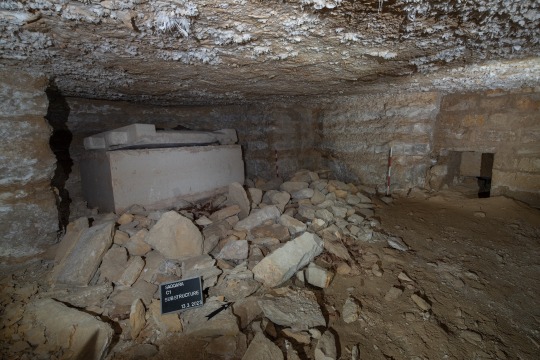
#A Lost 4400-Year-Old Tomb Found With Ancient Egyptian Mummy Inside#Ptahshepses#French scholar Auguste Mariette#ancient grave#ancient tomb#ancient artifacts#archeology#archeolgst#history#history news#ancient history#ancient culture#ancient civilizations#ancient egypt#egyptian history
92 notes
·
View notes
Text
Drawing Cuneiform, Part 3/3
(Previous)
So, how can we draw these signs in a way that's clear and legible, without getting too overcrowded and busy?
We have to make it clear where strokes start and end, because these three are all different signs (the sounds qa, me, and bar). This means we can't only mark the heads.

And we have to be able to mark multiple heads on a single stroke, because these two are different signs (the number 2, and the sound a). This means we can't only mark the tails.

So how can we achieve both of those goals, without ending up with a mess of heads and tails everywhere?
Well, it turns out some ancient scribes tried to solve the same problem!
Ashurbanipal, the last of the "great" kings of the Assyrian Empire, was known for being a horrifically cruel and bloodthirsty ruler (which is part of why he was the last of them). But he was also a great scholar, and he devoted a lot of his time and effort to building the Royal Library, which was meant to include all the knowledge of the world. It's thanks to this Royal Library that we have as much ancient Mesopotamian literature as we do today!
Like any good librarian, he made sure that every tablet filed in the Royal Library was properly labelled, and like any good emperor, he made sure they all had his own name on them, just in case. Usually this was stamped into the clay the normal way. But sometimes the tablets brought back from sacking a city had already been fired. What then?
Well, in exactly three specific cases, we've found this library information (the "colophon") written on in ink.

Here are zoomed-in images of the two I was able to find in the British Museum's collection. The third should be somewhere in there as well, but I haven't been able to locate it.


The text is pretty badly faded, but we know what it says based on other tablets from the Library: "Palace of Ashurbanipal, King of the World, King of Assyria".
Now this looks promising! This isn't just the improvised work of a scribe whose tablet dried too fast—according to Irving Finkel, the British Museum's cuneiform expert, the neatness and elegance of the writing suggests that there was a long tradition of this. Ink is just less durable than fired ceramic, and less likely to survive for the thousands of years it took us to rediscover these artifacts.
It's hard to extrapolate much from just these two inscriptions, but we can say a few things:
The heads are drawn with curved lines, and the tails with straight lines
Multiple tails can share one head, and multiple heads can share one tail
So let's see if we can render some text in this style! Here's what the full colophon should look like, if the rest of the text had survived:

I had to make a few guesses to make this work. We don't have any "Winkelhaken" strokes in the surviving text—the ones that look like big hooks, without a head or tail—so I just guessed at how they would be drawn.
But still, I think we've found our winner. This is the most readable style I've seen yet for writing cuneiform in two dimensions. You can see clearly where all the heads and tails are, you can tell the heads apart from the tails, and each wedge takes a maximum of two pen strokes to draw, a big improvement over our earlier versions!
So to finish off, here's how our Gilgamesh excerpt would look in this style:

Very readable, I think!
Next up: how exactly does this style work?
11 notes
·
View notes
Text
In the shadows of ancient civilizations, our ancestors left behind not just artifacts, but a trail of knowledge, wisdom, and identity. From towering pyramids to intricate writings on the walls, they etched their story into the fabric of time.
As we stand on the threshold of today, we have the privilege to unearth these treasures, to reconnect with OURStory, our truth, and our culture. Let's honor their legacy by reclaiming the narratives that weave through generations.
These echoes from the past remind us that we're not alone in this journey. They guide us to rediscover our roots, embrace our heritage, and empower our future. Let's walk this path of reclamation with reverence, unity, and the understanding that our strength lies in the legacy that's been passed down.

27 notes
·
View notes
Text
whenever i see something about the enneagram being an ancient system long-forgotten until it was rediscovered midway thru the 20th century i'm like ok and are the ancient artifacts proving the veracity of this statement in the room with us right now?
#enneagram#'we discovered a drawing of the 9 point circle in a cave' which of course means that the artist ugg was a type 4 caveman#bffr
5 notes
·
View notes